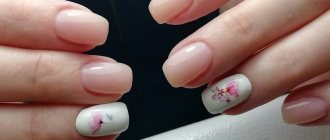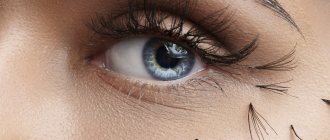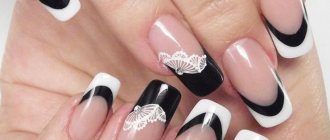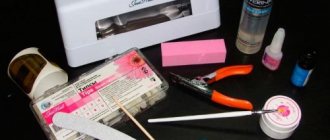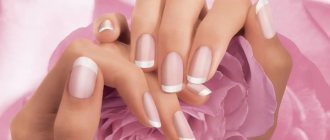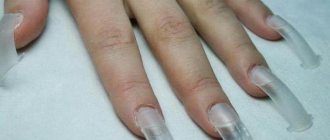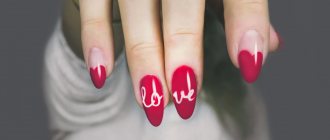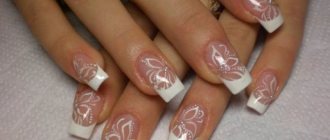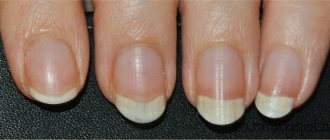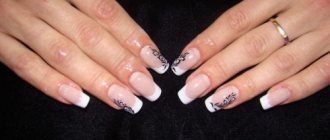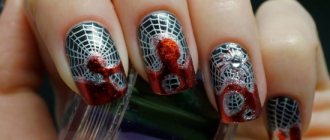What are tips and their history
Most girls know or have a rough idea of what tips are. Tips are frames shaped like a nail plate, made of plastic, nylon or polyflex.
The first plastic forms appeared back in the seventies; they were made by hand, so only noble people could wear beautiful artificial nails. They were the same length; due to the lack of manufacturing skills, the first tips were very thick and rough. Since 1974, mechanized production of tips began. Plastic heated to 150 degrees was poured into special metal molds. After cooling, the molds were opened and the finished tips were taken out.
How to extend nails with acrylic on top forms
Acrylic has several advantages over gel.
Firstly, you don’t need a special lamp to polymerize acrylic: it hardens in air.
Secondly, it is much stronger than gel. The disadvantage is an unpleasant pungent odor.
Acrylic extensions can also be done on lower forms or tips, similar to gel extensions. But, since these methods have already been described above, let’s consider extensions using upper forms.
What is it: the top forms are very similar in appearance to tips. The only difference is that they do not have a recess for gluing at the tip, and they have small “antennae” on the sides.
The technology is as follows: a small amount of material is placed inside the mold and leveled with a brush. This design is then applied to the nail.
After the acrylic hardens, the mold is removed and can be reused. The result is an extended nail with a perfectly smooth surface. This technique is quite simple, and even a beginner can handle it.
What is required for nail extensions on the upper forms
- Acrylic Powder;
- Monomer (liquid) is a special liquid that starts the hardening process at the moment of mixing with acrylic powder;
- Primer;
- Brush;
- Set of top forms for extensions.
To apply nail extensions on top forms you will need: acrylic powder, monomer, primer, brush, a set of top forms for extensions.
Materials for tips
Over time, nail extensions using tips became very popular, so plastic frames began to be produced in large volumes. Tips are made from various materials, often using three types of substances:
- Polyflex - frames made of this substance are often used when extending nails onto gel tips; this use is due to its fast and strong adhesion. The substance has good elastic properties and is not destroyed by acetone.
- ABS plastic - the name arose due to the components included in the substance, namely: acrylonitrile, butadiene and styrene. ABS is the most common material used to make tips. The frames are durable, highly elastic and have good adhesion to extension materials.
- Nylon is an impact-resistant material that holds its shape well, has high elasticity, and is easy to model. However, nylon frames are not suitable for nail extensions with tips at home, since they are difficult to glue to the nail plate.
Regardless of what material the tips are made from, they must be of high quality. To check reliability, you can slightly bend one of the frames along the length.
If, after a slight bend, a white stripe appears in the center, then the tips are of poor quality.
How to care for gel nails
The durability of extended nails largely depends on how the girl takes care of them. To do this, you must follow a number of simple rules:
- During wear, you need to lubricate the cuticle with a special oil so that the nails maintain a beautiful, aesthetic appearance until correction;
- It is recommended to renew the gel coating every 2-3 weeks, because, firstly: strongly grown nails look unkempt and ugly, and secondly: untimely correction of extended nails increases the risk of their breakage several times;
- During correction, old material must be filed off very carefully and carefully, preferably not with a file, but with the help of a special manicure device, so as not to damage your own nail plate;
- When working at home with various detergents and solvents, you must wear rubber gloves.
Thus, it is easy to perform gel extensions at home. To do this, you must have special tools and equipment, as well as strictly follow special instructions.
We recommend visiting our Manicurist Forum , where you can ask questions or chat about interesting topics!
Types of tips
Tips differ not only in the material from which they are made. They have different shapes and colors. To make nail extensions with tips easy, you should choose the right shape that suits a specific type of nail plate.
Tips forms
Tips are available in various shapes to create a specific nail design.
Varieties:
- Classic – have a smooth natural curve, suitable for almost all types of nails. Most often used by professionals. Often sold in packs of 50 copies, the cost is from 250 rubles.
- Straight - in this form of tips there is no contact zone, which is why they are also called non-contact tips. Due to the lack of a contact zone, they are often used for French design. For 150 rubles you can buy a set of 100 copies.
- Tapered tips - used to create nail shapes such as stiletto, bridget, and cat nails. The set includes 50 tips, you can buy a set for 150 rubles.
- Curved frames are indispensable for nail extensions using American style tips.
- Almond-shaped tips - used to quickly give the nail an almond shape. They come in different lengths, most often they do not have a contact zone, which makes it easier to create a French design. The price for 50 pieces varies from 100 rubles.
Each of the described types has a different length, which is written on the packaging. Manicurists use the maximum length of the tips; special clippers are used to change the length.
Color spectrum
In addition to the shape, the tips differ in color. Manufacturers produce a variety of colors to create the perfect manicure.
Kinds:
- transparent - ideal for almost any design;
- flesh or natural shade - to give nails a natural look;
- colored - it’s easy to draw a picture without using the main color of varnish;
- with a pattern - tips are used to quickly create a beautiful manicure;
- French tips for nail extensions - quickly create the perfect French manicure.
How to choose tips
Every girl wants her nail extensions to be as similar to natural nails as possible. In order to achieve this result, you should buy thin, but at the same time durable tips. The thicker the frame, the worse it will look on the nails. You shouldn’t skimp on the material; it’s better to buy tips from well-known companies so as not to end up with a fake.
When purchasing tips, you need to consider not only their length, but also their shape. The better the frame fits on the nail, the easier the extension process will be. If it is difficult to choose the appropriate size, then you can take slightly larger tips, apply them to the nail and use a file to remove excess edges.
When choosing tips, you should pay attention to the stop line, the length of the free edge and the contact zone. The free edge is thicker and longer than the contact zone. The stop line is a conditional separator between the contact zone and the free edge. The tip of the nail plate should rest against the stop line.
Tips should be cut with a tip cutter; do not use scissors or other cutting tools.
If the natural nail is slightly raised up, for convenience and a beautiful manicure, the free edge should be of medium length. For defects in the nail plate, it is best to use adhesive gel; it can fill cracks and grooves, smoothing out the natural nail.
Features of the contact zone
The contact zone is a thin part of the plastic frame, similar to a dimple. The recess should fit snugly against the nail and be in contact with it. Glue is applied to the contact area, only then the tip is glued to the nail plate.
The contact zone comes in different lengths. It varies from three to six millimeters. The shorter the nail bed, the smaller the contact area should be.
The contact zone can be:
- with several slots;
- round;
- deep;
- V – shaped;
- small;
- big.
During the extension process, the contact area is cut down. It is best to start nail extensions using tips at home with non-contact frames. In such types there is no possibility of design violation.
Video tutorials on nail extensions using tips
In the modern world, manicure can safely be called an integral part of a complete elegant look. It often happens that our nails are so brittle that this does not allow us to grow them to the desired length and give them the required shape. To solve all these and many other problems comes nail extensions using tips. Extended nails not only protect the natural plates from external harmful influences, but also allow you to create a deep design without any damage.
It's no secret that the French nail design is at the top of popularity among all nail designs. Extended nails for French manicure can be of various shapes. I bring to your attention videos with step-by-step instructions for nail extensions using French style tips.
Video tutorial “Gel extension technique”
Video tutorial “Acrylic extension technique”
I'll probably end here. It seems that I told you about everything and forgot nothing. Use the information for your health! If you have any questions while reading the article, feel free to ask them, I will definitely answer. Share your successes with me and show your results in photographs, if possible - I will be glad to see that you succeeded. Good luck to you!
Liquid tips
Progress does not stand still. Since 2010, liquid tips for nail extensions have become widely used in the nail industry. Such frames are made of flexible polymer material. Liquid tips are called because they contain a gel that has a liquid structure. The molds are very durable and can be used up to 200 times.
To work with liquid tips, you do not need to buy additional glue and many forms; you just need to purchase a gel and a rotating ultraviolet lamp.
The box contains 50 tips, such a set costs from 1500 to 2500 rubles. One set lasts professionals almost two years. Liquid tips save not only the time allocated for extensions, but also money. For beginners, the online store has the opportunity to purchase complete sets, which contain not only tips, but also a suitable gel for extensions.
Extensions with liquid tips
Step-by-step instructions for nail extensions using tips for beginners:
- remove cuticle in any convenient way;
- polish the nail plate;
- degrease the nail;
- apply primer coupling;
- attach the tip to the nail, choosing the most suitable size;
- determine the size; for this purpose, special markings are used on the form;
- Using a brush, put the gel into the liquid tip;
- coat the mold evenly to the selected length;
- glue the form with gel to the nail;
- holding the shape, dry the nail for 10 seconds under the lamp;
- after drying, remove the tips;
- Using a brush, apply a layer of gel to the finished substrate, forming a stress zone;
- dry the nail under the lamp;
- remove the sticky layer;
- shape the free edge;
- apply top gel, remember that it must be without a sticky layer;
- dry under the lamp for several minutes.
Video “Liquid Tips”
The video shows step-by-step instructions for gel nail extensions using liquid tips.
Advantages and disadvantages of liquid tips
Pros:
- easy to place on a natural nail;
- multiple use of tips;
- no need to apply glue to nails;
- no need to cut tips to give the desired length;
- creating a French manicure is faster due to the highlighted smile line;
- Can be used even on very short nails.
Flaws:
- Before using liquid tips, newcomers to the nail industry should attend lessons on gel nail extensions using tips.
- Not suitable for people with wide nail plates.
- You need a turning lamp; when drying in a regular UV lamp, the gel may spread.
Which type of extension is better?
It is impossible to say in advance which type of extension is right for you. The best option is to try working with both gel and acrylic using different techniques and decide which is closer to your liking.
Is it really possible to learn how to do nail extensions on your own or do you still need to take a course?
Many self-taught people often spoil their nails out of ignorance. The courses will tell you what is not on the Internet. Also, the need for training depends on the technology in which you plan to work. For example, salon modeling is easier and quite realistic to master on your own. But you can learn arch technique only in courses.
As part of the course, you will receive a large amount of theoretical knowledge about extensions. You can also practice under the guidance of an experienced master who will point out all the mistakes.
An important detail: after completing the training, a certificate is issued confirming successful completion of the program.
It will come in handy if you decide to make manicure your profession. Most clients trust their hands only to certified craftsmen.
Acrylic
Acrylic is a durable, quick-drying material. Acrylic nails are elastic; after extensions, the nails turn out thin and look natural. When using acrylic at home, you need to choose a well-ventilated room, as the substance has a specific aroma.
Extension tools
Before you move on to creating an artificial nail using tips, you should check if you have all the tools at hand.
List of materials:
- extension material – acrylic;
- primer or degreaser;
- liquid for dissolving acrylic - monomer, volume of at least 50 ml;
- set of tips;
- brush for applying acrylic powder;
- nippers for cutting tips;
- file with abrasiveness from 100 to 180 grit;
- lint-free wipes;
- buff;
- alcohol or other disinfectant;
- a jar with a lid will be needed for the monomer;
- dust removal brush;
- glue for tips;
- oil or cuticle softener.
After purchasing all the necessary materials, you can start creating beautiful nails.
Instructions
Before you start doing any manicure, you should wash your hands well with antibacterial soap. If this is not possible, then the skin of the hands is treated with a disinfectant, alcohol or antiseptic.
Extension process:
- File the free edge of the natural nail.
- Remove cuticles using an orange stick.
- Use a nail file to remove oily shine from nails.
- Choose the right tip for each nail; the contact area should cover less than half of the nail plate.
- The numbering of tips starts with the number 1 and ends with the number 10, the first size is the widest, then the width decreases.
- Arrange the tips after selection in order.
- File down the edge of the contact area on each frame.
- Degrease the nail plate.
- Apply glue to the contact area and distribute it evenly.
- The tips should be held at an angle of 45 degrees to prevent the glue from spreading.
- Apply the tip so that the stop line is in contact with the tip of the natural nail.
- Press the frame onto the nail plate and hold until it holds firmly.
- Adjust the length of the free edge using a cutter.
- Using a file, give the frame the desired shape.
- Use a buff to reduce the boundary between the tip and the natural nail, so that when you run your finger along the plate you don’t feel the bumps.
- Mix acrylic powder with monomer until a plastic mass is obtained.
- Using a brush, evenly distribute the acrylic mass along the entire length of the nail.
- You can remove excess thickness with a nail file.
- Apply a fixative to the nail.
After the fixative has completely dried, the nails can be covered with a single-color varnish or a special design can be created. For beginners, it is better to use colorless acrylic for nail extensions with tips, and a light pink color is suitable for French manicure. Extending nails with tips using acrylic is a very easy and simple procedure.
What are the differences?
- The significant difference between both procedures is time. So, it takes about 3-4 hours to create artificial nails. Not every woman decides to do this. Especially when it comes to a busy work schedule. Meanwhile, they can easily afford gel extensions. Under the guidance of an experienced specialist, it will not take much time.
- It is believed that when using the gel, the nail plate only becomes stronger. The same cannot be said about tips, the processing of which involves cutting off the top layer of the nail, thereby thinning and weakening it.
- It takes about 10-20 minutes to remove gel polish. Using tips you will have to wait up to 1.5 hours. In addition, the cost of the latter is an order of magnitude higher than that of a regular gel.
Gel
One of the main materials that nail art masters use to build up nail plates. The gel is easy to apply to the nail plate, it adheres well and does not dry out as quickly as acrylic. Therefore, nail extensions using gel tips will be an easy and fun procedure that even inexperienced nail technicians can handle.
Extension tools
The list of equipment needed for gel nail extensions is very similar to the list for using acrylic powder. The only acrylic powder and monomer are replaced with gel, and instead of a jar for liquid, an ultraviolet lamp and liquid are purchased to remove the sticky layer.
You will need three types of gels: camouflage or modeling gel, base and finishing gel.
Instructions for beginners
Step-by-step nail extension with gel on tips, the first 15 points are identical to acrylic extension. You should file your nails, remove oily shine and push back the cuticles. Starting from point 16, nail extensions with gel tips will differ from acrylic designs.
Gel application steps:
- open the jar of base gel;
- drop the gel into the center of the nail plate;
- distribute the material evenly over the entire surface of the nail, leaving 1 mm margins from the tank rollers and cuticle;
- dry the nail under ultraviolet light for 3 minutes;
- apply modeling or camouflage gel, leaving most of it in the stress area, in the cuticle area and on the free edge the layer of gel should be minimal;
- dry the layer under the lamp for three minutes;
- remove the sticky layer;
- form nail arches;
- using a file, make the free edge of the nail thinner;
- clean the nail with a brush;
- evenly distribute the gel finish over the nail;
- polarize the nail for 2–3 minutes;
- remove the sticky layer if the topcoat leaves it;
- Apply oil or emollient to the cuticle.
The gel allows the nails to breathe, it does not have a specific odor, which is why this material is more popular in contrast to acrylic powder.
French design
French manicure has gained its popularity a long time ago and still holds a leading position. French nail design can be done using two methods:
- Express - quick nail extensions using French tips. To do this, you need to buy special tips with a drawn smile line. Stick them on the natural nail and cover with finishing gel.
- The standard creation of a French jacket involves the presence of a light pink camouflage gel. It is applied after the base coat to the entire surface of the nail. After drying and removing the sticky layer, a smile line is drawn with white gel. Finally, you need to apply a finishing coat.
Glitter extensions
If you want to make a bright, shiny manicure, then the modeling gel can be mixed with glitter. It must be applied in the same way as described in the step-by-step instructions. To give a more saturated color, you can apply two shiny layers. Dry each separately under a lamp.
Nail care
To make artificial nails look beautiful and last longer, you should monitor their condition. It is advisable to make the first correction two weeks after the extension. Subsequent ones can be delayed for three to four weeks, it all depends on the growth rate of the natural nail.
When working with chemicals and large amounts of water, it is advisable to wear gloves to prevent your nails from peeling off. Do not allow sudden changes in temperature, as the gel nail may crack. You need to remove polish from artificial nails with a liquid that does not contain acetone. Extended nails should not be banged on a table or other hard objects.
Preparing nails for extensions: instructions
Here are some tips you should follow when getting extensions:
- Avoid damaging the cuticle approximately 4 days before extensions, i.e. Don't do a trim manicure.
- Make sure that the length of the regrown part of the nail is up to 3 mm. This is the optimal length for determining the shape, selecting plates and securely fixing the material.
- 12 hours before the procedure, do not apply cream to your hands, and 3 hours before extensions, avoid contact with water.
Nail preparation includes 5 stages:
- Cleaning your hands with alcohol or another antiseptic (chlorhexidine).
- Treatment of the cuticle - it must be softened and carefully moved to the base of the nail.
- Creating a form, i.e. filing the nail.
- Removing the fat layer. To remove shine, an abrasive file (up to 240 grit) is used, which is moved from the cuticle to the edge of the plate. Attention: nails that are too sharp may not be able to withstand lengthening and may begin to break. The fat layer is restored within 40 minutes, so calculate the time and complete this stage immediately before building up. A brush is used to remove the sawed layer from nails and fingers.
- Application of a primer, the effect of which is designed to last for 30 minutes. As soon as the nail is degreased, the laying out of artificial layers begins. If you miss time, the biological layer of the plate will be restored and the extended nail will quickly peel off.
Differences from extensions to forms
By looking at the table, you can understand which type of extension is best to use.
| Tips | Forms |
| If there is no free edge of the natural nail | Wide nail plate |
| A natural nail has a flat shape | Flat nail shape |
| Springboard nail shape | The free edge of the natural nail is strongly bent downwards |
| Deformed nails | |
| Nibbled nail plates |
Comparison with other extension methods
In addition to extensions using tips, methods of enlarging nail plates using forms are used. Disposable paper bases or reusable metal blanks are attached using an adhesive compound or a special clamp. Unlike tips, extensions on forms cannot be used on short nails. You need at least a small free edge to attach the artificial workpiece. After removal, paper blanks are thrown away, and metal ones can be reused after disinfection.
When choosing a method, you must rely, first of all, on the shape of the natural nail plates:
- For plates that bend downwards, the method on forms is suitable, since the growing end will not be very noticeable;
- Tips are suitable for those who have been bitten;
- Both methods are suitable for flat;
- For springboard-shaped ones, it is preferable to use tips; on forms, extensions are possible if gap correction is used with acrylic or gel.
A professional master will be able to apply extensions to almost any shape of nails in different ways. But we need to be fair to state the fact that there are a small number of real manicure masters. Therefore, it is better not to go by the opposite method when choosing a method.
Whatever extension technology is chosen, one should remember that an air cushion should not be allowed to form between the two surfaces. This will lead not only to rapid peeling, but also to possible infection of the natural plate.
Advantages:
- enlargement of nail plates in a short time;
- the material used does not cause allergic reactions;
- affordable method relative to costs;
- technology using tips is performed much faster than other methods;
- does not have a destructive effect on the nail structure;
- the possibility of gluing plates on nails that are delaminating and weakened by nature.
Flaws:
- difficult to disguise as natural nails;
- extensions using gel are more expensive than other methods;
- Duration of wear and strength are inferior to extensions on forms.
Advantages and disadvantages
Advantages:
- rapid increase in length;
- less chance of allergies;
- ease of extension, which even a beginner in nail art can easily handle;
- you can make smooth nails, even on deformed nail plates;
- You can create an exclusive nail design of maximum length and various shapes.
Flaws:
- it is difficult to achieve a natural look;
- in the first stages, large expenditures of money are required;
- Due to the thick free edge, artificial nails are inconvenient to use.
Advantages and disadvantages
Like any other procedure, nail extension using tips has its advantages and disadvantages. The list of the first can be found below.
- Using overlays you can achieve the desired result even if the natural nail plate has a minimum length.
- Considering the loads that the stress zone of extended nails has to face, it can crack and even break, which is especially important if it is not strengthened properly. The use of overlays allows you to avoid this trouble.
- Extending nails using tips is not difficult, but the same cannot be said about using forms. To successfully perform a procedure using onlays, no special skills are required (with rare exceptions), which makes visiting a specialized specialist unnecessary.
- Using tips, you can create complex shapes of nail plates with maximum ease.
As for the shortcomings of the products described, the main one is the “template” appearance. Despite the quality of the tips, they look less natural than nails extended using forms. Another noticeable disadvantage of the overlays is the large thickness of the tip, due to which some representatives of the fair sex do not like them. And also some girls note that such products often come off. This problem should not be considered typical, since it is caused by the use of low-quality glue and other gross violations on the part of the performer.
